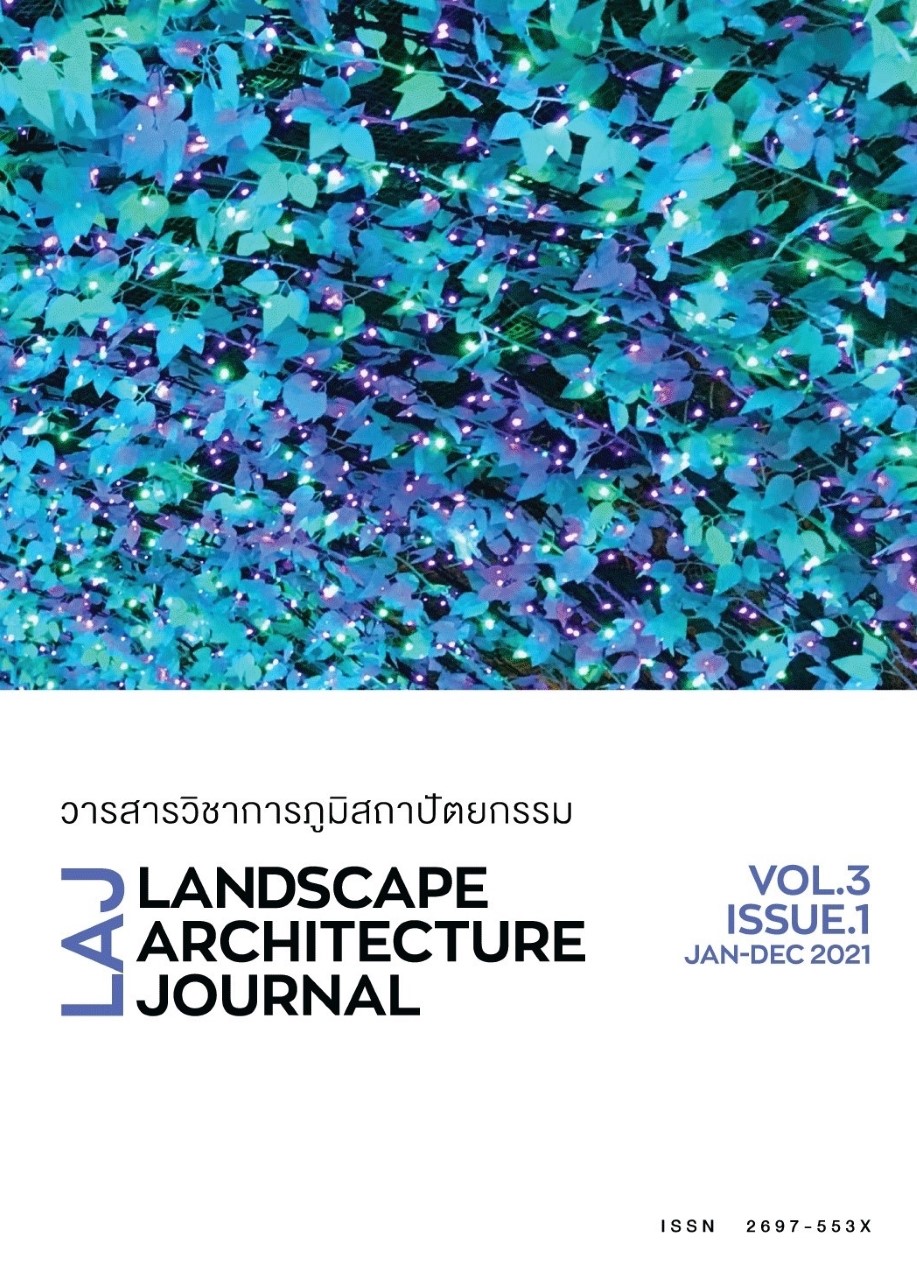Water Management in Rural Area with Nature-Based Solution: A Case Study of Valley Communities in Ban Pi, Ban Luang District, Nan Province, Thailand
Main Article Content
Abstract
This study focuses on the possibilities of water management in a rural valley community area by using the Nature-based solution as a concept. Study area is located in Ban Phi, Ban Luang District, Nan province, agricultural villages in Northern Thailand. In this study, the qualitative research method of collecting and analyzing data with the landscape ecology concept is applied. The result gains an understanding of human and landscape relationships, conditions, and potentials. Subsequently, reviews of nature-based solutions are required in order to develop the solutions in restoring ecosystem functions and human well-being. This area has a large amount of water supply in the wet season. Although reservoirs and check dams are constructed, the site unable to retain water in the dry season. The water management method demonstrates two solutions to deal with the site conditions and demands of water. The first solution, restoration of plant stripes on slopes and stream riparian areas to maintain soil moisture, filter, and reduce water runoff. Another solution is modifying agricultural water usage to be more efficient by integrated agroforestry system into traditional agriculture. With these solutions, green and blue infrastructures are created and enhanced to provide ecological functions on a landscape scale.
Article Details

This work is licensed under a Creative Commons Attribution-NonCommercial-NoDerivatives 4.0 International License.
References
กรมชลประทาน, สำนักบริหารจัดการน้ำและอุทกวิทยา, ศูนย์อุทกวิทยาชลประทาน ภาคเหนือตอนบน. (2564). ข้อมูลน้ำฝนรายเดือนและรายปี สถานีตรวจวัดวิจัยและปลูกป่าบ้านหลวง จังหวัดน่าน. สืบค้นจาก https://www.hydro-1.net/Data/Admin/uploadfile/view_upload_public.php?select=สถิติข้อมูลน้ำฝนรายเดือนและรายปี เมื่อวันที่ 26 มกราคม 2564
กรมชลประทาน, สำนักอุทกวิทยาและบริหารน้ำ, ส่วนการใช้น้ำชลประทาน. (2554). คู่มือการหาปริมาณการใช้น้ำของพืช ปริมาณการใช้น้ำของพืชอ้างอิงและค่าสัมประสิทธิ์พืช. สืบค้นจาก http://water.rid.go.th/hwm/cropwater/iwmd/pdf/rev_cwr_manual.pdf
กรมชลประทาน. (2558). คู่มือการปฏิบัติงาน คู่มือการประเมินการใช้น้ำ ในกิจกรรมต่างๆ, น.8-5. สืบค้นจาก http://idi.rid.go.th/training/2558/Volume 08.pdf
กรมพัฒนาที่ดิน กระทรวงเกษตรและสหกรณ์. (2563). สถานภาพการชะล้างพังทลายของดินในประเทศไทย. สืบค้นจาก http://e-library.ldd.go.th/library/flip/bib10329f/bib10329f.html
ธีระพล ตั๊งสมบุญ. (2549). การใช้นํ้าของพืช. สืบค้นจาก http://irre.ku.ac.th/books/pdf/20.pdf
นักรบ สายเทพ, อรกมล นิละนนท์, และ อัตนา วสุวัฒนะ. (2564). โครงการจัดทำผังภูมินิเวศเพื่อศึกษาศักยภาพของพื้นที่ชุมชนท้องถิ่น พื้นที่ศึกษา ตำบลบ้านพี้ อำเภอบ้านหลวง จังหวัดน่าน. (เอกสารไม่ตีพิมพ์เผยแพร่).
เพชร มโนปวิตร. (2559). ได้เวลากลับไปหาธรรมชาติ Nature-based solution for all. สืบค้นจาก https://greenworld.or.th/green_issue/ได้เวลากลับไปหาธรรมชาต-2/?fbclid=IwAR0ah5ZDs0HrV6dAdLCjHjMUAV8Q2DDiMXS8coKVUmMqOyIAiDkg60zPy9M เมื่อวันที่ 28 กุมภาพันธ์ 2564
ริชาร์ด เบอร์เนตต์. (2549). ทางเลือกในการทำวนเกษตรสำหรับไร่และสวนขนาดเล็กบนพื้นที่สูง. สืบค้นจาก https://uhdp.org/wp-content/uploads/2012/07/Agroforestry-Thai-web.pdf
ศูนย์ปฏิบัติการน้ำอัจฉริยะ กรมชลประทาน. (ม.ป.ป.). ปริมาณการใช้น้ำของพืชอ้างอิงโดยวิธี Modified Penman. สืบค้นจาก http://water.rid.go.th/hwm/cropwater/CWRdata/ETo/MP-North.htm เมื่อวันที่ 28 กุมภาพันธ์ 2564
สำนักจัดการที่ดินป่าไม้ กรมป่าไม้. (2562). โครงการจัดทำข้อมูลสภาพพื้นที่ป่าไม้ ปี พ.ศ. 2561 - 2562 รายงานฉบับสมุบูรณ์. สืบค้นจาก https://www.forest.go.th/land/wp-content/uploads/sites/29/2020/03/rfd_forestarea 2561_62_final_report.pdf
องค์การบริหารส่วนตำบลบ้านพี้. (2563). ข้อมูลระบบสารสนเทศภูมิศาสตร์ตำบลบ้านพี้ Shape file [ข้อมูลอิเล็กทรอนิกส์]. ระบบฐานข้อมูล (Database).
Cohen-Shacham, E., Walters, G., Janzen, C., & Maginnis, S. (2016). Nature-based Solutions to address global societal challenges. Gland : IUCN.
Cooper, R. (2020). Nature-based solutions and water security. Retrieved from https://www.edie.net/news/4/GWI---449bn-must-be-invested-in-water-annually-to-meet-SDGs/
Cristiano, S. (2018). Systemic Thoughts on Ecology, Society, and Labour. Through the Working Class. Culture Del Lavoro, 8, 9-24. http://doi.org/10.30687/978-88-6969-296-3/001
Food and Agriculture Organization of the United Nations. (2018). Nishi-Awa Steep Slope Land Agriculture System, Japan. Retrieved from http://www.fao.org/giahs/giahsaroundtheworld/designated-sites/asia-and-the-pacific/nishi-awa-steep-slope-land-agriculture-system/detailed-information/en/
Forman, R. T. T. (2019). Towns, Ecology, and the Land. London: Cambridge University Press.
Forman, R. T. T., & Godron, M. (1986). Landscape Ecology. New York: Wiley.
Forsyth, T. (2014). Sustainable Land Use and Rural Development in Southeast Asia: Innovations and Policies for Mountainous Areas. Mountain Research and Development, 34 (1), 76-77. https://doi.org/10.1659/mrd.mm132
Hawes, E., & Smith, M. (2005). Riparian Buffer Zones: Functions and Recommended Widths. Yale School of Forestry and Environmental Studies. Retrieved from http://eightmileriver.org/appendicies/09c3_Riparian%20Buffer%20Science_YALE.pdf
Lacombe, G., Valentin, C., Sounyafong, P., de Rouw, A., Soulileuth, B., Silvera, N., Pierret, A., Sengtaheuanghoung, O., & Ribolzi, O. (2018). Linking crop structure, throughfall, soil surface conditions, runoff and soil detachment: 10 land uses analyzed in Northern Laos. Science of the Total Environment, 616–617 (2018), 1330–1338. https://doi.org/10.1016/j.scitotenv.2017.10.185
Lehmann, L. M., Smith, J., Westaway, S., Pisanelli, A., Russo, G., Borek, R., Sandor, M., Gliga, A., Smith, L., & Ghaley, B. B. (2020). Productivity and economic evaluation of agroforestry systems for sustainable production of food and non-food products. Sustainability (Switzerland), 12 (13), 1–9. https://doi.org/10.3390/su12135429
Liu, Y. B., & Smedt, F. De. (2004). WetSpa Extension, A GIS-based Hydrologic Model for Flood Prediction and Water-shed Management Documentation and User Manual. Retrieved from https://www.vub.be/WetSpa/down-
loads/WetSpa_manual.pdf
Millennium Ecosystem Assessment. (2005). Ecosystems and Human Well-being: Synthesis. Washington, DC: Island Press.
Ong, C., Anyango, S., Muthuri, C., & Black, C. R. (2007). Water Use and Water Productivity of Agroforestry Systems in the Semi-arid Tropics Why Farmers Integrate Trees and Crops in Drylands One of the principal biophysical premises. Annals of Arid Zone, 46 (3&4), 255–284.
Sloping Agricultural Land Technology (SALT). (2012). How to Farm Hilly Land without Losing Soil.
Tokushima Tsurugisan Global Agricultural Heritage Promotion Council. (2018). Agriculture and Living in Nishi-Awa About Nishi-Awa Steep Slope Land Agriculture System.
United States Environmental Protection Agency. (2021). What is Green Infrastructure? Retrieved form https://www.epa.gov/green-infrastructure/what-green-infrastructure
United States Geological Survey. (2021). SRTM 1 Arc-Second Global [Data file]. Retrieved from https://earthexplorer.usgs.gov/

